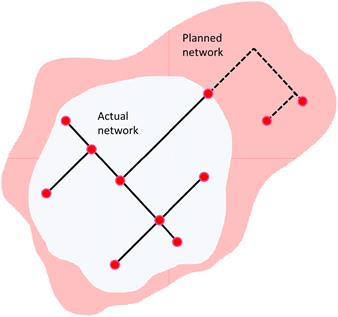Model concepts
A model in NetSim is made up of:
· A network geometry - a number of pipes connected to one another in nodes
· Boundary conditions - Values for pressure, flows, powers and temperatures which are given to nodes and pipes. These values can be given directly to the pipes and nodes, but also be applied to these indirectly via other objects such as pumps, production plants, etc.
· Calculation parameters such as general load factor, ambient temperature, etc.
In NetSim, all objects such as pipes, nodes, pumps, etc. are collected in the same database and the model constitutes, in the actual sense, the “linking” of the above data which has taken place under a model name in the database. This means that one and the same object may be included in several models in the database. Regarding the objects as actual physical objects which can be assigned different properties in different models makes this easier to understand.

Objects in the database are identified by an internal ID and a unique name. This means, for example, that two pipes in two models with the same name are one and the same object but with two sets of attributes. A set of attributes in either model.
Models can be of two different types, normal mode or planned mode.
In the database, it is assumed that a model of a pipe network describes normal mode. This model is assigned normal mode type in the model form. All other models which include nodes and pipes from this model are planning models and are assigned planning model type.
When a model describing normal mode is present, it is recommended that you create a planning model which is a copy of the normal mode model and that you assign the model type planning to this copy. You can delete and add pipes and nodes in this planning model without affecting the normal mode model.
When an object, node or pipe is present in two models and the object is deleted in one of the models, the object disappears in this model only. The object remains in place in the other model. The object is also deleted from the database only when the object appears in only one model.
A planning model can be expected to become obsolete as the normal mode model is changed. This is why the content of a planning model should be checked against the foundation on which it is based if it is used after a period of dormancy. This check can take place graphically by visually comparing a drawing from the relevant model or by applying an appropriately formulated SQL script which compares the content of the two models and points out the differences between the models.